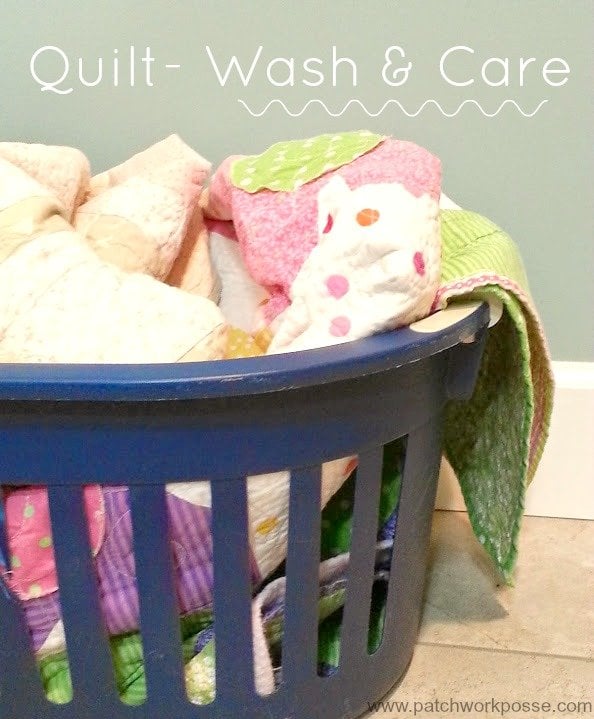I find that the funnest part of sewing up a quilt is seeing it being used. I’m a fan of having quilts all around the home for others to use. They are draped on chairs, couches, foot stools…whetever. They are easily grabbed and snuggled with.
When you are a believer in using them, there comes a point when that quilt needs washing. There are little spots, fingerprints, yummy snacks and more that get a little inbedded in the quilt.
What do you do? Let’s talk today about how to take care of your quilt – wash and care.

I know there are a few out there that say they will never wash a quilt– and while that’s find for quilts that you make as an heirloom, others might find a good washing is needed.
Before we begin– you can review an article on what to do with your fabric after you buy it and before you sew with it……Do you PREWASH or not? This is an ongoing answer and chat here if you want to chime in here.
Hand or Machine Wash?
Before you toss that quilt into the washer, you might want to go over a few things:
- Is there fabric used in the quilt that might bleed? Red and blue are natorisous colors that run into others when water hits them. You might want to test a section of the fabric before washing it to make sure you don’t give yourself more work in the end if they do bleed.
- Is there handwork that might come apart? If the whole quilt is needle turn applique without any fusible underneath, I wouldn’t wash that in a machine. There is too much agitation and the threads and stitching might be pulled and the applique could come off.
- Along with applique– what about embroidery? Is there alot? Could it be comprimised while washing?
How to Hand Wash Your Quilt:
1) Fill a clean large tub or sink with cold water, pour in liquid detergent that is gentle, perfume and dye-free and add 1/2 cup vinegar to brighten quilt.
2) Immerse quilt into water and gently move the quilt around. After 10 minutes in the water, drain and re-fill tub with fresh water to remove soap from quilt.
3) Drying, remove wet quilt and put in a white sheet as a “sling”. This quilt is going to be sooooo heavy! Watch out! Don’t pull on the quilt or the threads and stitching could pull. Lay it inside a bed sheet and then lift it out pulling on the sheet and not the quilt itself.
4) Lay quilt on dry towels and cover with a layer of dry towels and roll up. Gently push on quilt, unravel and lay the quilt flat on another set of dry towels until completely dry. Use a fan on low for quicker drying, or lay outside –not in direct sunlight or under a tree.
How to Machine Wash Your Quilt:
Make sure the drum of your machine is large enough to hold the size of quilt you are washing. These can become lopsided when wet and through your machine off.
1) Use cold water and a gentle detergent specific for quilt washing and
2) Wash on the delicate cycle
3) Dry on a air dry or gather the quilt in a ‘sling’ again and take outside to dry.
Never hang wet quilts as this will certainly ruin it quickly.
When I sew up a quilt, I make sure that for the most part it is washable. I am a low maintanance kind of quilter. I don’t do fussy work and if it is, I make sure it’s secured to the quilt top and can handle a good wash.
Some quilts –like baby quilts or twin quilts- will be washed more often than others becuase of what age of person is using it. Make sure it is thouroughly dry before you use it or store it. You don’t want it to become musty.
What dow do you take care of your quilt? Have a favorite soap or method? We’d love to hear about it.

Becky Jorgensen is the creative quilter behind Patchwork Posse, the Patchwork Planner and her online quilt group Patchworkers Plus. You can find her patterns in books, magazines, and her quilt membership. Gather your quilting supplies, organize your sewing space, explore the process of disappearing quilt blocks, or finish a free quilt pattern. I'll help you use what you have, finish what you start and make your quilting journey fun!
Follow me here: Facebook, Pinterest, YouTube







My first machine quilting teachers said she washes all her quilts after finishing them.
She uses a capful of retayne and adds a color catcher sheet to avoid bleeding .
I have taken this advice and have never had a quilt bleed. If the color catcher is extremely colorful I will wash the quilt a second time. I also give a few color catcher sheets with the quilts I give away.:))
Great advice! Thanks for sharing. I will have to take a look at the products you mentioned.
Hi Becky.. Small suggestion: Have someone proofread your posts for spelling errors before you post them. 🙂
Sue- thanks for the suggestion. I am a kind of gal who just types, types and types. I re-read them yes, but there are a few errors that always allude me. I will try harder.